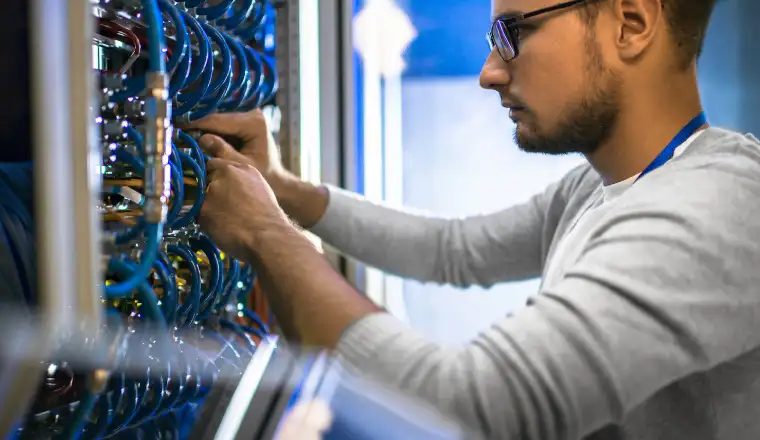We already see the great power of our internet technology. However, do we truly know the full scope of our responsibility when we’re expected to contend with an anonymous and invisible enemy? This article takes a deep dive into the cybersecurity discussion and how your company’s intangible resources take centre stage in the discourse. In this cybersecurity guide for businesses, we first place the threats side-by-side with the cornerstones of cybersecurity. Then, we delve into the most common threats seen online before exploring measures to protect your company from online hazards.
Keeping in mind that the cybercrime incidence was previously thought to occur once in every 39 seconds, it is not unfounded to surmise that the frequency of cyberattacks could only go higher as the internet grows faster and bigger. With an astonishing 300% increase in cybersecurity breaches following the global lockdown, your company’s intellectual property faces yet another hazard as it remains the most commonly mined asset online. However, with these new threats come new ingenious solutions.
To borrow from one of the literary canons, Dylan Thomas, we should rage, rage against the breaching of rights.
What is Cybersecurity?
Cybersecurity encompasses an array of processes, practices, and programs designed to protect electronically-stored data, as well as the network on which these are located. Threats to cybersecurity range from identity theft to compromised intellectual property.
The hazards, which we will be discussing in detail as we go deeper into the subject, are mostly qualified into three main threats:
- Disruption – follows a lack of vigilance and utter reliance on an unsecured network. This could lead to a premeditated internet outage, illicit control over the Internet of Things (IoT), or even intimidation of higher-ups to divulge sensitive information.
- Distortion – refers to the loss of integrity of stored data, the danger of which ranges from operations to public misinformation.
- Deterioration – pertains to the erosion of official control over the whole network, thereby subverting privacy and data protection laws.
Cybersecurity was developed—and is continuing to be developed—to protect the public, including your company. It is the duty of cybersecurity experts to keep us safe from cyberthreats through the implementation of these eight elements of cybersecurity:
- Application Security
- Information Security
- Network Security
- Business Continuity Planning
- Operational Security
- End-user Education
- Employee Training
- Leadership Commitment
These elements aim to deter the cyberthreats growing in sophistication by the minute. However, the knowledge about our protection measures, along with the general idea of what we’re up against—these are all abstract ideas unless we identify the matters in danger.
Get to Know What You’re Protecting
Before jumping into the ravine of cybercrime dens, identifying what exactly we are meaning to protect would help in finding the best routes around online threats. Here is a quick rundown of the most commonly compromised information online:
- Personally Identifiable Information (PII) – encompass any data that directly points to a particular person, such information could be used for identity theft, harassment, or other nefarious activities.
- Employee Information and Records – are data relating to your employees’ information. These include their names, addresses, contact information, and other official records that could be used for malicious purposes. Furthermore, this information could be compromised to alter performance metrics and assessment programs. Moreover, the employee may not be the actual target, but rather a mere step to entering your company system.
- Access to Bank Accounts – could compromise your company’s financial stability by conducting unauthorised transactions, usually through cryptocurrencies such as bitcoin.
- System Applications – relates to processes accorded to protect specific applications used in a company, particularly productivity or perhaps financial processing programs. Although this is mostly implemented during the development phase, there are also third-party applications that serve the same purpose.
- IoT and Physical Security – may seem unrelated to digital protections. However, with our increasing reliance on connecting an array of physical services online through the IoT, hacking into the grid could compromise large-scale operations like transportation, electrical disruption, or even water-treatment facilities.
- Patents Information – give holders a legal recourse should someone decide to steal or infringe on your patented product. This could be a particular target of competing companies to gain an advantage over other players.
- Company Trade Secrets – are sensitive information native to or produced within the company; they are relevant information that could potentially damage operations when divulged. These could contain your business plan or even your company’s contingency plans. Having these documents exposed to other parties, especially competitors, would allow them to circumvent your defence plans should they mount a cyberattack against your company.
Now, Here’s Why You Should Start Protecting
The mentioned information and intellectual property rights are acknowledged by experts to comprise a significant portion of your company’s value. So, it makes sense—an insidious one, at that—for criminals to target these types of assets. More than that, it is only reasonable for businesses to invest in protecting their intellectual property through cybersecurity.
Expert Insight: By the year 2030, studies show that 90% of the projected world population will join the online community. And as proven by history, the incidence of crime grows alongside population expansions. The same proves true even for the online community. And although the advanced technical capacities of cybercriminals could be to blame, the upsurge in targets equally contributes to the statistics.
Cybersecurity for small business expenditures, in light of the unprecedented rise in digital crimes, are expected to hike to around $6 trillion by 2021. Clearly, even if we assume an inflated error margin for this prediction, the reality still stands—companies worldwide are taking arms against cybercrime.
Cybercrime: The Rhyme and Reason, Or the Lack Thereof
Online criminal operations are motivated by varying considerations. But perhaps, the overriding factor for the majority of cybercriminals is instant profit. Having questionable moral boundaries – or superficial ones, to say the least – cybercriminals are willing to impinge on other organisations’ or individuals’ rights for their selfish gain. Hence, rational discussion is out of the table from the outset. Besides, most of these cyberattacks hide under the veil of anonymity. This, however, is not to say that we don’t stand a chance against the hackers.
Scoping the Battleground
The combat against cyberthreats, similar to other online battles such as fighting the counterfeits, starts with identifying the enemy.
Generally, advanced persistent threats (APTs) constitute the majority of cybercrimes, both in frequency and gravity. To illustrate this concern, surveys reveal that 58% of IT security experts think that their companies are definite targets of cyberthreats. In contrast, only 4% consider their enterprise safe from digital criminal activities.
Expert Insight: Of those companies thinking that APTs could compromise them, the prevailing belief is that the threats originate from at least one, or a combination of these five entities: direct competitors, hacktivists, foreign state-sponsored attackers, governmental intelligence agencies, or even their employees.


Tricks and Threats: Forms of Cyberattacks
To identify whether APTs target your intellectual property, recognising concealed threats is crucial. Mostly, corrupted files are the vectors of cyberattacks. But these are by no means the only forms in which APTs appear on your screen. Most of the time, they do not appear at all. Therefore, familiarising yourself with the following cyberthreats is absolutely necessary:
- Malware: It is a shorthand for malicious software. These are inserted into a system to undermine the confidentiality, integrity, or availability of data. Malicious programs could be used to expunge patent records or corrupt the whole intellectual property portfolio. Meanwhile, malware specifically designed to stealthily track personal activities and invade the victims’ privacy is referred to as spyware.
The National Institute of Standards and Technology provides some steps to prevent and deal with malware. Generally, proactive measures should be able to deter malicious programs. These are practices such as:
-
- diligent scanning of attachments;
- avoiding questionable sources especially when .exe files are involved;
- limiting the use of removable data storage devices;
- restricting administrator access to a few trusted individuals;
- and regularly updating operating systems.
- Ransomware: It is precisely what it sounds like. It takes hold of sensitive data such as your company’s IP records and holds it for ransom. Transactions are usually coursed through untraceable or convoluted online channels. Digital currencies such as bitcoins are popular modes of ransom payment. Only after providing the demanded amount would the data owner gain access to the compromised files. And even then, the return of stolen data is not a hundred per cent guaranteed.
Unfortunately, these programs are rarely detected before it's too late. This is where the importance of a solid backup plan, a cloud server, or a remote backup server comes into the fore. Additionally, it is always best to devise a concrete incident mitigation plan.
- Crypto-jacking – works by attaching malicious programs to home or work computers to “mine” for cryptocurrencies. Since bitcoins and the like require a tremendous amount of processing power, freeloading on other unsuspecting computers may hasten their process. While it seems relatively insignificant since they are not actively stealing any data from your company, the hazard lies on slowing down your entire network. After all, their immense computing requirement takes from your network’s productivity.
- Man-in-the-Middle Attack (MitM) – refers to an anonymous party sneaking between conversations without getting detected. They either passively extract information by monitoring the exchanges, or they could actively hack the system to look for specific data.
- Drive-by Attack – is particularly damaging since there is no action required from the end-user. Merely visiting a website, which is not necessarily the source of the attack but rather a victim to a separate entity, could enable the computer virus.
- Social Engineering – takes advantage of human psychology to gain access to restricted information. The perpetrators usually present themselves as amiable persons or even direct relatives of the target. Their aim is always to steal information that they otherwise wouldn’t have authorised access over.
- Distributed Denial of Service (DDoS) Attacks – render online services inoperative by flooding the system with bot-generated traffic from multiple locations. These attacks are strategically planned for a significant amount of time. Planting the bots on different sites in itself takes a lot of time. Moreover, DDoS attacks are usually decoy-acts, providing distractions for other types of fraudulent activities.
- Spam & Phishing – involves unwanted messages coursed through email. They either install malicious programs on the receiving device or trick the user to divulge personal information thinking that they are giving them for legitimate reasons.
Like the incident prevention measure for other cyberthreats, the FBI outlines similar actionable tips for preventing phishing attacks. As per official recommendation, you should:
-
- remember that authorised entities rarely ask for sensitive personal information, especially online.
- Furthermore, utilising a phishing filter program,
- avoiding links from shady emails,
- or keeping away from unrealistic promotions are proven ways to stay away from internet frauds.
- Corporate Account Takeover (CATO) – is a large-scale cyberattack targeting business operators and company owners. The hackers take the identity of the business to wire unauthorised transactions and steal funds through automated clearing house (ACH) payments. Cybercriminals usually infiltrate the company security system through malware or programs masquerading as legitimate software. CATOs particularly pose an enormous threat for small and medium-sized enterprises (SMEs) as they are significantly more vulnerable to attacks. Massive losses are almost always guaranteed after falling victim to a CATO.
Preserving Your Company Through Cybersecurity
Given the persistence of cyberthreats, along with its stealthy nature, your company could be at risk on any given day. A significant portion of your company’s survivability depends on strategic contingency plans.
Protect your company from threats online and even from risks offline through our complementary consultation. Get in touch with our expert attorneys through [email protected], or give us a call so we can talk about your business. You can reach us at +97142822677.
Frequently Asked Questions
Why should my company care about cybersecurity?
Cybersecurity protects your company’s sensitive information – your employees’ records, financial data, trade secrets, and other digitally stored materials that give a competitive advantage to your company.
I have an antivirus, I am safe, right?
While having an antivirus system in place deters some attacks, more sophisticated forms of cyberthreats or advanced persistent threats (APTs) bypass the conventional antivirus system and still have the potential to infect your network. The two-pronged approach to the issue should include a dedicated IT team, and a focused IP law firm should legal actions be necessary.
What can I personally do to maintain my cybersecurity?
Proactive measures could be taken, such as vigilant watch for dubious links, attachments, programs, or the like. Furthermore, educating yourself with the kinds of threats online as discussed in this article would help you dodge potential attacks.
Why would my company be targeted by cyberattacks?
Research suggests that 58% of companies, regardless of the size, believe that they are definitely targeted by cyberthreats. When asked where they think the threats originate, they outlined the following: direct competitors, hacktivists, foreign state-sponsored attackers, governmental intelligence agencies, or even their employees. These factors also apply to any company, including yours.
How often do threats to cybersecurity happen?
The last data estimates that data breach happens once every 39 seconds. However, with a 300% increase in reported incidence recently, the frequency of cybercrimes became significantly higher.






